[English] 日本語
 Yorodumi
Yorodumi- PDB-7nur: Structure of the Toxoplasma gondii kinase Ron13, kinase-dead mutant -
+ Open data
Open data
- Basic information
Basic information
| Entry | Database: PDB / ID: 7nur | |||||||||
|---|---|---|---|---|---|---|---|---|---|---|
| Title | Structure of the Toxoplasma gondii kinase Ron13, kinase-dead mutant | |||||||||
 Components Components | Protein kinase domain-containing protein | |||||||||
 Keywords Keywords | TRANSFERASE / secretory pathway / kinase | |||||||||
| Function / homology |  Function and homology information Function and homology information | |||||||||
| Biological species |  | |||||||||
| Method | ELECTRON MICROSCOPY / single particle reconstruction / cryo EM / Resolution: 3.125 Å | |||||||||
 Authors Authors | Korkhov, V.M. / Mehta, V. | |||||||||
| Funding support |  Switzerland, 2items Switzerland, 2items
| |||||||||
 Citation Citation |  Journal: Nat Commun / Year: 2021 Journal: Nat Commun / Year: 2021Title: Structural insights into an atypical secretory pathway kinase crucial for Toxoplasma gondii invasion. Authors: Gaëlle Lentini / Rouaa Ben Chaabene / Oscar Vadas / Chandra Ramakrishnan / Budhaditya Mukherjee / Ved Mehta / Matteo Lunghi / Jonas Grossmann / Bohumil Maco / Rémy Visentin / Adrian B Hehl ...Authors: Gaëlle Lentini / Rouaa Ben Chaabene / Oscar Vadas / Chandra Ramakrishnan / Budhaditya Mukherjee / Ved Mehta / Matteo Lunghi / Jonas Grossmann / Bohumil Maco / Rémy Visentin / Adrian B Hehl / Volodymyr M Korkhov / Dominique Soldati-Favre /   Abstract: Active host cell invasion by the obligate intracellular apicomplexan parasites relies on the formation of a moving junction, which connects parasite and host cell plasma membranes during entry. ...Active host cell invasion by the obligate intracellular apicomplexan parasites relies on the formation of a moving junction, which connects parasite and host cell plasma membranes during entry. Invading Toxoplasma gondii tachyzoites secrete their rhoptry content and insert a complex of RON proteins on the cytoplasmic side of the host cell membrane providing an anchor to which the parasite tethers. Here we show that a rhoptry-resident kinase RON13 is a key virulence factor that plays a crucial role in host cell entry. Cryo-EM, kinase assays, phosphoproteomics and cellular analyses reveal that RON13 is a secretory pathway kinase of atypical structure that phosphorylates rhoptry proteins including the components of the RON complex. Ultimately, RON13 kinase activity controls host cell invasion by anchoring the moving junction at the parasite-host cell interface. | |||||||||
| History |
|
- Structure visualization
Structure visualization
| Movie |
 Movie viewer Movie viewer |
|---|---|
| Structure viewer | Molecule:  Molmil Molmil Jmol/JSmol Jmol/JSmol |
- Downloads & links
Downloads & links
- Download
Download
| PDBx/mmCIF format |  7nur.cif.gz 7nur.cif.gz | 196.4 KB | Display |  PDBx/mmCIF format PDBx/mmCIF format |
|---|---|---|---|---|
| PDB format |  pdb7nur.ent.gz pdb7nur.ent.gz | 150.5 KB | Display |  PDB format PDB format |
| PDBx/mmJSON format |  7nur.json.gz 7nur.json.gz | Tree view |  PDBx/mmJSON format PDBx/mmJSON format | |
| Others |  Other downloads Other downloads |
-Validation report
| Summary document |  7nur_validation.pdf.gz 7nur_validation.pdf.gz | 712.1 KB | Display |  wwPDB validaton report wwPDB validaton report |
|---|---|---|---|---|
| Full document |  7nur_full_validation.pdf.gz 7nur_full_validation.pdf.gz | 719.3 KB | Display | |
| Data in XML |  7nur_validation.xml.gz 7nur_validation.xml.gz | 37.9 KB | Display | |
| Data in CIF |  7nur_validation.cif.gz 7nur_validation.cif.gz | 57.3 KB | Display | |
| Arichive directory |  https://data.pdbj.org/pub/pdb/validation_reports/nu/7nur https://data.pdbj.org/pub/pdb/validation_reports/nu/7nur ftp://data.pdbj.org/pub/pdb/validation_reports/nu/7nur ftp://data.pdbj.org/pub/pdb/validation_reports/nu/7nur | HTTPS FTP |
-Related structure data
| Related structure data |  12600MC M: map data used to model this data C: citing same article ( |
|---|---|
| Similar structure data |
- Links
Links
- Assembly
Assembly
| Deposited unit | 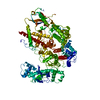
|
|---|---|
| 1 |
|
- Components
Components
| #1: Protein | Mass: 126419.680 Da / Num. of mol.: 1 / Mutation: D595A Source method: isolated from a genetically manipulated source Source: (gene. exp.)  Strain: ATCC 50853 / GT1 / Gene: TGGT1_321650 / Cell line (production host): Sf9 / Production host:  |
|---|---|
| Has protein modification | Y |
-Experimental details
-Experiment
| Experiment | Method: ELECTRON MICROSCOPY |
|---|---|
| EM experiment | Aggregation state: PARTICLE / 3D reconstruction method: single particle reconstruction |
- Sample preparation
Sample preparation
| Component | Name: Secretory pathway kinase Ron13 / Type: ORGANELLE OR CELLULAR COMPONENT / Entity ID: all / Source: RECOMBINANT |
|---|---|
| Molecular weight | Experimental value: NO |
| Source (natural) | Organism:  |
| Source (recombinant) | Organism:  |
| Buffer solution | pH: 7.5 Details: 5 mM Tris pH 7.5 / 200 mM NaCl / 0.5 mM EDTA / 3 mM DTT |
| Specimen | Conc.: 15 mg/ml / Embedding applied: NO / Shadowing applied: NO / Staining applied: NO / Vitrification applied: YES |
| Vitrification | Cryogen name: ETHANE |
- Electron microscopy imaging
Electron microscopy imaging
| Experimental equipment |  Model: Titan Krios / Image courtesy: FEI Company |
|---|---|
| Microscopy | Model: FEI TITAN KRIOS |
| Electron gun | Electron source:  FIELD EMISSION GUN / Accelerating voltage: 300 kV / Illumination mode: FLOOD BEAM FIELD EMISSION GUN / Accelerating voltage: 300 kV / Illumination mode: FLOOD BEAM |
| Electron lens | Mode: BRIGHT FIELD |
| Image recording | Electron dose: 47 e/Å2 / Film or detector model: GATAN K2 QUANTUM (4k x 4k) |
- Processing
Processing
| CTF correction | Type: PHASE FLIPPING AND AMPLITUDE CORRECTION |
|---|---|
| Symmetry | Point symmetry: C1 (asymmetric) |
| 3D reconstruction | Resolution: 3.125 Å / Resolution method: FSC 0.143 CUT-OFF / Num. of particles: 320723 / Symmetry type: POINT |
 Movie
Movie Controller
Controller


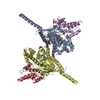
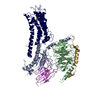
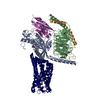
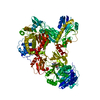
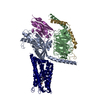
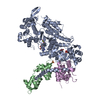
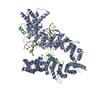
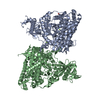
 PDBj
PDBj